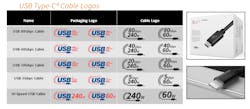The USB Implementers Forum (USB-IF) is the manager of all things dealing with the Universal Serial Bus (USB). The Type-C connector not only dominates USB implementations, but older versions still exist and the protocols remain upward-compatible. I talked with Jeff Ravencraft, President and COO of USB-IF (see video above), about the latest technical capabilities and the new branding that should make it easier for consumers to understand what they're buying.
These days, the top speed limit of USB on a Type-C connections is 80 Gb/s in both directions (see figure). There's an interesting but unlabeled version pushing 120 Gb/s in one direction and 40 Gb/s in the other (same total throughput) that targets high-resolution multiple-monitor support, but most will utilize 80-Gb/s or lower speeds.
In addition, the USB power-delivery standard now cranks out up to 240 W of power. In theory, certified cables must run at least at the 400-Mb/s Hi-Speed USB rate. These days, though, the 5 Gb/s over a Type-C cable tends to be the minimum needed for data transfers.
Likewise, the 5-W limit of the much older USB connections has been replaced with a 60- and 240-W standard. These are specs for the cable and the power delivery (PD) of a source. The power requirements of a device are negotiated by the USB PD protocol. Multiple voltages and current settings can be supported by USB devices now to provide a more flexible and power-efficient interface. It's also possible for a device to be a source as well as a sink at different times. This allows a smartphone to power a display or a display could charge a smartphone.
The new PD standard adds three fixed voltages to the mix: 28, 36, and 48 V. The prior standard included 5, 9, 15, and 20 V. It's also possible to have an adjustable voltage between 15 V and the three new higher voltages in the mix. In addition, it allows devices to negotiate the amount of power provided with a 100-mV resolution.
USB4 Version 2 is the latest standard; Version 1 was announced a while ago. The most recent USB Power Delivery standard is Version 3.1. The USB4 standard is aligned with alternate protocols that support DisplayPort Revision 2.1 and PCI Express Revision 4.

